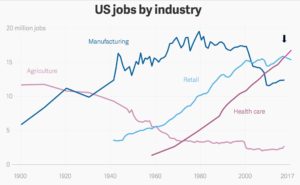Dr. Eric Topol recently posted an interesting image on Twitter. According the US Bureau of Labor Statistics, Healthcare jobs exceeded Retail jobs:
We believe this is unsustainable, as employee direct and associated costs are a major portion of healthcare spending.
Depending on your point of view, this trend is ripe for disruption and value creation, or under threat of attack from technologies.
But which ones? And in which areas? Here are a few:
Distribution & Logistics: Online retailers are absolute masters of product sourcing, logistics, and distribution. Check out this video on Amazon’s Robots for an example…very few employees in sight:
Drug warehouses are no different. Their application of robotics and automation is just as impressive.
However, our industry will continue to push this trend of replacing employees with robots and computers.
How long will it be before drug products are robotically loaded onto self-driving cars and trucks, and delivered directly to pharmacies for patient receipt?
Or flown via drone directly to patients’ homes?
The technology is here already. It’s perhaps a question of time, investment, and regulatory change.
Blockchain – When most people hear “blockchain,” they think cryptocurrency, like BitCoin.
However. the underlying distributed blockchain database paradigm can be applied to any series of transactions.
Medical records is an obvious place where the application of blockchain can increase efficiency and security. Indeed, there is no reason why, in 2018, we should be filling out paper forms and making photocopies of insurance cards whenever we visit a new physician.
Regulatory filings could be processed much more quickly using blockchain. Imagine an FDA approval in a few days after an NDA submission?
How many FDA employees would pay the price of lost employment for this?
Artificial Intelligence – Here is a term which gets batted around quite a bit in our industry. Defining it and its many applications is a challenge. However, what is abundantly clear is that machine learning and decision margin has the potential to accelerate drug discovery and development.
Indeed, combining all three of these categories would do wonders for drug development, accelerating clinical trials, accelerating regulatory processes, and saving money.
It’s the “saving money” bit that important when looking at it from a labor perspective. What does “saving money” mean?
Two things…first, the investment that is not made, i.e., due to an early tox signal, is an investment that can be made in another area.
But second, it also means the employees who are replaced by all of these robots and blockchains and smart machines…machines who do not have to eat, pay mortgages, or save for retirement.
Problem?
One problem with all of this is the sheer size and complexity of our healthcare system. Thus, this process will likely proceed very slowly. Indeed, Amazon’s potential entry into drug distribution is a relative small step in the entire value chain.
However, where there is complexity and overhead, there will be companies with automation and software solutions which reduce costs and accelerate transactions.
It’s happened in retail and other sectors, and healthcare will not be any different.
SaveSave

